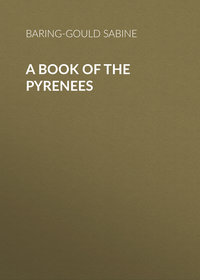 полная версия
полная версияOld Country Life
But to this arrangement followed another, more practical and convenient, that of having a grand corridor up-stairs, out of which opened the doors of the bedrooms; or, where there was a glazed-in quadrangle with staircase and landings around it, there the doors of the bedrooms opened from these landings. The corridor was used as a room for dancing, or for music, or for games; it was the recreation place of the house on a rainy day. Being up-stairs, and away from library and parlours, the young people might skip, and play blind-man's buff, dance, and disturb no one; nor was there much furniture in these corridors to stand in the way and get knocked over.
This corridor is a feature of an old house so very dear to young folks, and so very advantageous to their health, that it is a pity in our modern houses we have got rid of it.
A word on the furniture of our old country houses must not be omitted. Unfortunately there set in at the beginning of this century a most detestable fashion in furniture, absolutely void of taste; and to make room for the villainous articles then imported into our old country houses, much beautiful old work was turned out, very often was given to servants when they married. The consequence is, that much of it passed into cottages, where it soon got destroyed. It was not only old carved oak that was cast forth, for much of that had been got rid of in the Georgian epoch, but even the beautiful polished wood cabinets, chests of drawers, and Chippendale chairs of a more recent period.
Of early furniture, I mean mediæval, little remains in our houses, for one reason, because there was in them very little. The era of furniture was begun with the Tudor monarchs; it was all of oak, and the carving was influenced much by Holbein, who inspired artists with admiration for German Renaissance. Cabinets with architectural façades and heavy oak furniture continued in the Elizabethan and Stuart periods. The date of a chair can be told approximately by the position of the rail binding together the legs. The primary object of this brace was, to hold the legs firmly, but it was also found to possess the not less important advantage of providing a person sitting in the chair with the means of keeping his feet from the cold stone-slabbed pavement. When boarded floors came into fashion, it became no longer necessary to have the front brace of the chair placed so near the floor, and to give more freedom to the feet it was gradually heightened. Some time after this the side braces were raised to the same level as the front brace, and later still, as the first necessity for their use was gradually lost sight of, they were dispensed with altogether. This was the first step towards the bad system of construction now almost universally practised, of leaving the legs of chairs without any support at their lower extremities. At the beginning of this century a still further deviation from right principles ensued. The legs of chairs were made to curve, and often to curve in such a manner as to make them unserviceable for supporting the weight reposed upon them.
"Let us examine an old oak chair, and see how it was constructed. In the first place, we shall find that the whole of the work is executed in solid oak, the uprights forming the back, and the back legs being made of one continuous piece; this at once gives strength and backbone to the whole structure. The framework holding the seat is next securely tenoned, and pinned with oaken pegs into the four legs, thus binding the whole of the parts firmly together. Even at this stage we have a far more strongly constructed piece of work than the modern chair when quite completed; the old workman, however, not content with this, next turned his attention to the weakest part of all – the feet of the chair – and securely fastened them together about three or four inches from the floor with four strong braces, tenoning each brace at both ends into the legs of the chair, and securing it, as before, with oaken pegs. This last addition made the whole a perfectly strong and almost indestructible piece of framing, and constitutes one of the most essential differences in the construction of ancient and modern furniture. The legs of most modern chairs are made to depend entirely for strength on their hold, at one end, to the framing of the seat of the chair, into which they are generally only glued. The legs of the ancient chair, on the other hand, are secured at both ends; and the four braces connecting them together act as struts as well as ties; they form an admirable protection against any blow the chair may receive at its lower extremities. Many of the old chairs constructed on these excellent principles are now in good condition, after nearly two hundred years of daily use."[2]
In mediæval times there were trestles and boards for a dining-table; but in Chaucer's time fixed tables were coming into use. He tells how that in the rich and luxurious Franklin's house there were —
"Alle deyntees that men cowde thynke,* * * * * *His table dormant in his halle alwayStood redy covered al the longe day."The "table dormant" was used only by very rich people; it was a new fashion at the close of the fourteenth century, and was expensive. It took its name from the fact that it was slept upon at night; it served as a bed for one of the men who lay in the hall. This table consisted of a single long trestle with a plank on it. It had but two legs, one at each end, and a beam between supported by struts. But at the same time that these tables came into fashion, another variety was in use, supported by a pair of short trestles at each end. The top of this table was also formed of planks, but they were hinged together so as to be easily folded up and removed, when additional space was required. A table of this kind is referred to by Shakespeare in Romeo and Juliet, when, as Capulet enters the hall with his guests, he exclaims —
"Come, musicians, play.A hall! a hall! give room, and foot it, girls.More light, you knaves; and turn the tables up."A remarkably cleverly constructed table of the reign of Elizabeth exists at Slade in South Devon. It is based on the plan of the table dormant, but is convertible into a settle when no longer required as a table; the planking rests on the settle arms when serving for a board, and slides back and assumes an erect position when required as a settle back.
A "drawing-table" was a third variety. It was one that was square framed, but could be drawn out at both ends, so as to nearly double its normal length.
In a paper on 'Our Household Furniture,' contributed to the Art Journal by Mr. G. T. Robinson, an illustration of one of these tables is given; and in speaking of the ingenuity displayed in the construction of the sliding leaves, he says, "The whole mechanism is admirably considered for the purpose it has to fulfil. Indeed its adaptation for its purpose was so good that the principle was long retained; and Sheraton, so late as the commencement of the present century, advocates its use for many writing or other tables, and gives the rule for finding the exact rake of the slides, and the technical details of all the other parts."
It is difficult to understand why so admirable and simple an arrangement was abandoned, for anything more clumsy and unsatisfactory than the method adopted in our modern dining-room tables for accomplishing a similar result can hardly be imagined.[3] The only modern examples I have seen are some manufactured by a firm in Brussels (Wattier, Steenpoort).
I confess that I look back with regret to the old highly polished mahogany table for dessert. The modern system of covering the table with white, and strips of coloured silk, and setting it with sprigs of ferns and flowers is very pretty, but then for the sake of this prettiness we are letting the polish of our tables go down. Hardly anywhere now does the butler care to keep up the polish of the table; he used to take a pride in it, now he knows that it is never seen. Yet I know of two or three old country houses into which the Russian fashion has not penetrated, and where even to this day the mahogany is shown, and shines like a mirror.
"Hail, good comrades, every one,Round the polished table;Pass the bottle with the sun,Drink, sirs! whilst ye're able.Life is but a little span,Full of painful thinking;Let us live as fits a man,No good liquors blinking!"So sang our grandfathers; but the song has gone out with the polished table, and with the polished table the quiet enjoyable drinking of good port and sherry after the retirement of the ladies. The cigarette is lighted – and who can enjoy port with the air full of its perfumes? – and no sooner is the wine begun to be appreciated, than the tray of coffee is presented, dug into the side, as a reminder that now-a-days the pleasant hour with good wine and agreeable male companions is cut down to a quarter of an hour – has gone out of fashion, along with the polished table, and we must away into the drawing-room to talk empty nothingnesses, and listen to bad music.
But we must not spend too much time over tables and chairs. Marquetry became the fashion under William and Mary, when upright clocks, bureaux, and chairs were thus decorated. Under Louis XIV. a new style of decoration was introduced by one André Charles Buhl, who gave his name to it. He was chief upholsterer to the king, and his rich and brilliant marquetry of tortoise-shell and brass, so combined as to form figures and subjects, was extensively used in the furnishing of the new palace at Versailles.
The fashion extended to England, and where tortoise-shell was not employed, the ground was gilt, then painted over with black, leaving a pattern in gold uncovered, and the whole was washed over with a reddish-brown lacquer, which gave the effect of tortoise-shell. Spaces thus treated were relieved by raised work in wood carved and gilt in relief, in representation of Buhl's brass work. We find this chiefly in mirror and picture-frames.
Then followed the reign of Louis XV., the age of rococo, of shell-shaped curves set against each other back to back. It may have been barbarous, but it was rich and beautiful. Then walls were painted white and picked out with gold, the clearest, most brilliant, turquoise-blues and rose-carmines came in. Painters devoted themselves to the decoration of panels in the walls of rooms and to ceilings, the dessus-de-portes, over-doors, generally in chiaroscuro, shepherds and shepherdesses, nymphs, cherubs. There was a certain amount of sombreness in the old Elizabethan house, in the dark oak panelling, in the olive-greens of the tapestry, that was distasteful to the merry men of the epoch from Charles II. to the first Georges, and they set themselves to make their interiors as sparkling with gold and brilliant colour as possible on a white instead of a dark ground.
The discovery of Pompeii caused a return to a simpler style of decoration, to purer forms; and marquetry furniture was manufactured in exotic woods, enriched with ormolu mountings. Paintings were executed on copper and let into chimney-pieces, of great delicacy and charm.
Chippendale, Heppelwhite, and Sheraton are names associated with the mahogany furniture of the last century, with tables with pierced galleries, chairs with open strap work backs, cabinets of graceful curves, all of admirable workmanship. Indeed cabinet-making never attained a higher degree of delicacy and perfection than at this period. I would point to some of the bureaux of this date as real marvels of workmanship. And look at the backs of the chairs – a good Chippendale chair has the upright curled back at the top, in a manner remarkable for beauty, and right in principle, for it exposes no sharp angles to suffer from a blow. The satin-wood furniture, some of it with medallions painted on it, sideboards, work-tables, chiffoniers, sometimes only decorated with delicate garlands of laurel or bay painted or inlaid on the satin-wood, is not to be disregarded. The only furniture that cannot be loved is that of the first thirty years of this century, when it violated all true principles of construction, and manifested neither invention nor taste in design.
Before leaving the consideration of old country houses, one word must be said about their setting. We now-a-days, when we build a mansion, look out for the top of a hill, a good windy, exposed spot. It never occurs to us that half the charm of a house consists in the way in which it is framed. The mediæval Germans lived on the tops of rocks, but then their houses were castles, partly for defence, and partly because they knew what was fit to be done. Artistically, they made these castles eminently picturesque with towers and gables that cut the sky. We do not now build castles, but – well, the word is suitable – boxes; and a box looks like a box on the top of a hill against the sky, and nothing can make it look other. Our English forefathers, in their sense of security, and in their love of sun and shelter, sought out a hillside, and built their mansions so as to have rising ground behind it, to back it, and where they had not a hill, there they had a wood of tall trees. A house thus set is like a picture in a frame, a pretty face in a real bonnet. I do not think that ladies who, in pursuance of a vile fashion, wear hats, can be aware of the loss of charm to the face. Let them take an ancestral portrait out of its frame, and hang it thus naked against the wall. They will see at once that the frame insulates it, draws attention to its beauties and enhances them. It is the same with a house. It may be good architecturally, but unless it be backed up by a green hill covered with wood, tall Scotch pines, the haunt of rooks, umbrageous beech, in autumn trees of gold, it is nothing but an architectural study. How naked, how forlorn a dear old house looks that has lost its timber that surrounded it! I know one or two old mansions that have been converted into farm-houses, and their rear-guard of timber hewn down and sold. There is a broken-hearted look about them that reminds one of a carriage-horse degraded to go in a cart. It feels its degradation, loses flesh, gloss, and spirit.
I was one day walking with an old friend whom fate doomed to live abroad all his life, but whose heart was ever in his native land. We were strolling near an old mansion, in its park, when he stopped, looked at it, and said, "Ye gentlemen of England, that dwell at home at ease – and in what ease! in what peace and beauty! Indeed, I think that, as in all the world there is not a type of man nobler, better, more complete in every way than the true English gentleman, so do I think that nowhere – not approachably even, anywhere – is there to be found a house like the old English country house." And in my heart I responded, Amen – It is so.
CHAPTER IV
THE OLD GARDEN
JUST before the breaking forth of the French Revolution, the Abbé de Lille composed a poem in four cantos, entitled Les Jardins, in which he enthusiastically urged the abandonment of all formality in the laying out of a garden, and the adoption of the new English style of irregularity.
"Avant de planter, avant que du terrainVotre béche imprudente entame le sein,Pour donnez aux jardins une forme plus pure,Observez, connoissez, imitez la nature."An agreeable wildness – that was what was to be sought. The Revolution came in, and hacked the gardens about, and reduced them all to the state of wildness.
What the Abbé de Lille wrote against was the artificiality of the garden arrangement that had been in vogue till then. Horace Walpole had already written in the same strain. A rage had set in in England for remodelling the gardens, and the new fashion was called "English gardening."
Pliny the younger, in his delightful letters, speaks of his gardens. As his Laurentine villa was his winter retreat, it is not surprising that the gardens there take no prominent part of his account. All he says of them is, that the gestatio, or exercise ground, surrounded the garden, and was bounded by a box-hedge; where the box had perished, there were planted tufts of rosemary. He mentions his vine-walk and his trees, mostly mulberry and fig, as the soil was unsuited for other trees. On his Tuscan villa he is more diffuse; the garden takes up a good part of the description. He tells of the strange shapes into which his box-trees were clipped, his slopes, his terraces, shrubs methodically trimmed, a marble basin, fountain, a cascade, bay-trees alternating with plane-trees, a long straight walk, from which branched off others hedged by apple-trees in espalier, and by box, and ornamented with obelisks. Something like a rural view was, indeed, contrived amidst so much artificiality, but was speedily forgotten amidst the stiff lines of box and the trimmed cypresses.
In the paintings of Herculaneum we see the representations of gardens; they are square enclosures, formed by trellis-work and espaliers, and regularly ornamented with vases, fountains, and statues, elegantly symmetrical. Now this arrangement of a garden continued in Italy. It never changed, and the villa gardens in and about Rome to this day reproduce the plans and character of those that flourished there in the classic age.
The villa-gardens in and about Rome! I cannot write the words without an ache of heart, for I know that they are disappearing rapidly, inevitably. Along the Via Salaria I saw three in process of destruction during the late winter and spring of 1889. A great slice of the Borghese grounds is being devastated to make room for hideous streets and squares. The Wolkonski gardens have been curtailed; those of Villa Massimo Arsoli adjoining, almost destroyed and built over; the Rospigliosi gardens gone; others doomed; the glorious Ludovisi gardens, with their cypresses and ilexes towering above the closed Porta Pinciana and the ancient boundary wall, are in process of extermination. "The grounds, which were of an extent extraordinary when considered as being within the walls of a capital, were laid out by Le Nôtre, and were in the stiff French style of high-clipped hedges, and avenues adorned with vases and sarcophagi. With the fury against trees which characterizes Italians, all the magnificent ilexes and cypresses were cut down as soon as the land was secured, and the plots of building-land rendered altogether hideous and undesirable. In a few years not a trace will remain of the picturesque glories of this once noble villa, which, if acquired by the municipality, who refused to purchase it, might have been made into public gardens of beauty unrivalled in any European capital." [4]
The railway station, with its sheds and sidings, occupies the once matchless gardens of the Villa Massimo Negroni, celebrated for its exquisite cypress avenues and its stately terrace, lined with ancient orange-trees and noble sarcophagi. The ground was confiscated by the State, and the destruction of this fair scene broke the heart of the owner, Prince Massimo. The sweet gardens of the Villa Strozzi are gone, now built over with ugly houses. Outside the Porta Pia grand old gardens are being devastated also.
The Medici gardens remain; Hawthorn thus described them. "They are laid out in the old fashion of straight paths, with borders of box, which form hedges of great height and density, and are shorn and trimmed to the evenness of a wall of stone at the top and sides. There are green alleys, with long vistas, overshadowed by ilex-trees; and at each intersection of the paths the visitor finds seats of lichen-covered stone to repose on, and marble statues that look forlornly at him, regretful of their lost noses. In the more open portions of the gardens, before the sculptured front of the villa, you see fountains and flower-beds; and, in their season, a profusion of roses, from which the genial sun of Italy distils a fragrance to be scattered abroad by the no less genial breeze."
The Boboli gardens at Florence remain to testify to the ancient arrangement, with high walls of evergreens and long avenues hedged up ten or twelve feet, dense and impervious, above which rise the spires of cypress and the domes of the stone-pine.
Our English gardens were modelled on those of the Italian palaces, the same subdivision of squares into sections, with trimmed box enclosing them, and with a statue or a fountain, or a carved and shaped yew in the midst. The gardens were invariably enclosed within walls. Where the ground sloped, at great expense it was shaped into terraces, reached by flights of steps. The greatest exactness in the design was aimed at. As Pope observed —
"Each alley has a brother,And half the garden just reflects the other."When Pamela endured her persecution she was allowed to walk in the garden, but this was so walled round that escape from it was impossible. There were seats in it on which she might repose in the sun. There was a fish-pond in which she might angle, but there was only one garden-door by which egress could be obtained, and that was locked. It was the same with Clarissa Harlowe. The garden of her father's house was walled round.
The pleached alleys were constructed of lime or beech trees platted and trimmed so as to form walls of green. They were over-arched, and those walking in them were as in a green bower. I know an old château on the Moselle with such a berceau, it has in it windows commanding beautiful reaches of the river; otherwise it is completely enclosed by leaves, and fresh and sweet it is as a walk on a hot day. In England we required shade less than shelter, and the green funnels were not in such request as the long lines of lofty yew or box hedge.
In King's Views of the Seats of our Nobility and Gentry, at the beginning of the eighteenth century, we see the utmost formality. Every house is approached by two or three gardens, consisting perhaps of a gravel-walk and two grass-plats, or borders of flowers. Each rises above the other by two or three steps, and as many walls and terraces, and so many iron gates.
Sir William Temple gives us his view of what constituted a perfect garden in his day. "The perfectest figure of a garden I ever saw, either at home or abroad, was that of Moor Park, in Hertfordshire. I will describe it for a model to those that meet with such a situation, and are above the regards of common expense. It lies on the side of a hill, upon which the house stands, but not very steep. The length of the house, where the best rooms and of most use or pleasure are, lies upon the breadth of the garden; the great parlour opens into the midst of a terrace gravel-walk that lies even with it, and which may lie about three hundred paces long, and broad in proportion; the border set with standard laurels and at large distances, which have the beauty of orange-trees out of flower and fruit. From this walk are three descents by many stone steps, in the middle and at each end, into a very large parterre. This is divided into quarters by gravel-walks, and adorned with two fountains and eight statues, at the several quarters. At the end of the terrace-walk are two summer-houses, and the sides of the parterre are ranged with two large cloisters open to the garden; over these two cloisters are two terraces covered with lead and fenced with balusters; and the passage into these airy walks is out of the two summer-houses at the end of the first terrace-walk. The cloister facing the south is covered with vines. From the middle of the parterre is a descent by many steps into the lower garden, which is all fruit-trees, ranged about the several quarters of a wilderness, which is very shady; the walks here are all green, and there is a grotto embellished with figures of shell rock-work, fountains, and water-works."
Nothing could be more formal, and nothing, I think, could be more charming. Why should we imitate wild nature? The garden is a product of civilization. Why any more make of our gardens imitation wild nature, than paint our children with woad, and make them run about naked in an effort to imitate nature unadorned? The very charm of a garden is that it is taken out of savagery, trimmed, clothed, and disciplined. The wall and hedge are almost necessaries with us, to cut off the wind. See how flowers of all kinds luxuriate, if given the screen from the biting blast! If they like it, why should not we?
I allow that the hacking of trees into fantastical shapes deserved the scourge administered in the one hundred and seventy-third number of The Guardian, Sept. 29th, 1713. The writer there says – "How contrary to simplicity is the modern practice of gardening; we seem to make it our study to recede from nature, not only in the various tonsure of greens into the most regular and formal shapes, but even in monstrous attempts beyond the reach of the art itself; we run into sculpture, and are yet better pleased to have our trees in the most awkward figures of men and animals, than in the most regular of their own. A citizen is no sooner proprietor of a couple of yews, but he entertains thoughts of erecting them into giants, like those of Guildhall. I know an eminent cook, who beautified his country-seat with a coronation dinner in greens, where you see the champion flourishing on horseback at one end of the table, and the queen in perpetual youth at the other.









